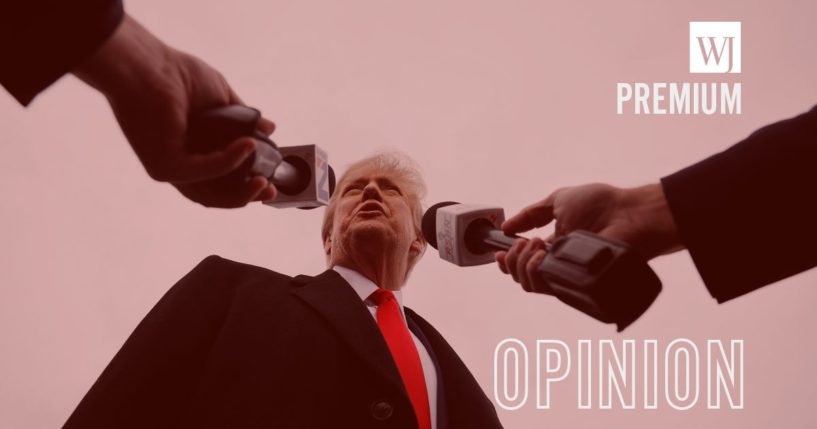
Bannon Predicts Trump Will Destroy Deep State in First 100 Days - Here's How He Could Do It
Former President Donald Trump intends to crush tyrants and restore the American republic to the sovereign people.
In an interview with The Epoch Times published on Thursday, podcaster and former Trump strategist Steve Bannon predicted that the 45th president — should he win the 2024 presidential election — will mimic the New Deal era’s frenzy of activity and destroy the deep state within his first 100 days in office.
“FDR, in his first 100 days, started the foundations of building the administrative state, the deep state. The first 100 days of President Trump, I think you’ll see the beginning of the deconstruction of that,” Bannon said.
The host of the “War Room” podcast certainly raised expectations with such comparisons. To match the pace of President Franklin D. Roosevelt’s legendary first 100 days in 1933, Trump would have to hit the ground running.
The question, of course, is how and to what purpose? What might a 100-day destruction of the deep state look like?
Here are some possible answers:
Defining the “Deep State”
First of all, when determining what we mean by the “deep state,” we must not resort to Supreme Court Justice Potter Stewart’s oft-quoted 1964 definition of pornography: “I know it when I see it.”
Indeed, to root out an evil as deep as the deep state, we must understand its component parts.
To qualify as part of the deep state, an entity must satisfy three requirements:
- First, it must have only the most tangential relationship to the Constitution written and ratified by the sovereign people.
- Second, its principal actors must have no direct accountability to the people through elections.
- Third, it must have a set of interests distinct from those of the sovereign people and therefore hostile to them.
Now, let us examine how others — both friendly and unfriendly to Trump — have described the deep state.
Bannon, of course, referred to FDR’s first 100 days as the “foundations” of the deep state. This would mean that the podcaster had in mind a phalanx of enthusiastic administrators who tried (and failed) to make the New Deal work.
“The day of enlightened administration has come,” Roosevelt promised in a 1932 campaign speech.
In practical terms, this meant that the federal government must have more control over Americans’ lives. It created a broad and deep regulatory state full of petty tyrants.
On Sunday, former Republican presidential candidate Vivek Ramaswamy paraphrased a message he delivered while personally endorsing Trump at a New Hampshire rally last week.
“The real divide isn’t black vs. white or even Democrat vs. Republican. It’s the managerial class vs. the everyday citizen,” Ramaswamy posted on X.
The real divide isn’t black vs. white or even Democrat vs. Republican. It’s the managerial class vs. the everyday citizen.
— Vivek Ramaswamy (@VivekGRamaswamy) January 21, 2024
FDR’s “enlightened” administrators have become Ramaswamy’s “managerial class.”
Previously, however, Ramaswamy has made it clear that the deep state goes beyond the FDR-inspired regulator tyrants.
On the primary debate stage in early December, for instance, he argued that the deep state played a sinister role in the Jan. 6 Capitol incursion, the rigging of the 2020 presidential election, and the Russian collusion hoax.
“The real enemy is not Donald Trump. It’s not even Joe Biden. It is the deep state that at least Donald Trump attempted to take on,” Ramaswamy said.
🚨 Vivek Ramaswamy Challenges Mainstream Narratives: Deep State – 9/11 – Jan 6 – Stolen Election
”The real challenge lies in the Deep State, an entity that Donald Trump, at the very least, attempted to confront.
I find it perplexing that I am the sole person on this stage… https://t.co/W0HCTYi3gS pic.twitter.com/l1TmGjCSg0
— Mario Nawfal (@MarioNawfal) December 7, 2023
Those comments completed the picture of the deep state in the minds of many Trump supporters.
It consists not only of federal agencies but also — and perhaps especially — federal law enforcement and the “national security establishment,” including what President Dwight D. Eisenhower famously called the “military-industrial complex.”
Trump’s establishment media opponents, of course, have painted a very different picture.
The Atlantic, for instance, described the deep state as a beleaguered and “faceless mass of civil servants,” unfairly targeted.
Not to be outdone in shilling for the establishment, Newsweek called the deep state “a supposed network of shadowy and powerful figures secretly controlling the government and a frequent feature of right-wing conspiracy theories.”
In sum, from regulatory tyrants to entire federal agencies with the means to morph into a modern-day Gestapo, the deep state has many hideous faces.
How Trump Could Destroy the Deep State
When contemplating his approach to the deep state, Trump must weigh three options: replacement, reform and revolution. He could, of course, choose a mixture of these approaches.
Replacement
Replacement might begin with the renewal of Schedule F.
In October 2020, Trump issued an executive order making it easier to fire certain federal employees.
By reclassifying them as Schedule F employees, the president would have the authority to fire as many as 50,000 federal workers and replace them with “America First” loyalists.
In fact, according to a 2022 report from Axios, Schedule F constituted the “centerpiece” of a “radical plan” for Trump’s second term.
When President Thomas Jefferson once dismissed a small number of federal officers, he could not believe how the others complained.
“The whole herd have squealed out, as if all their throats were cut,” Jefferson wrote in 1802.
We should expect much the same today, only amplified by the modern sense of entitlement and the establishment media treating federal bureaucrats as objects of pathos.
Doreen Greenwald, president of the National Treasury Employees Union, told Fortune that Trump and his allies have targeted the wrong people.
“Federal employees are not the enemy,” Greenwald said. In fact, they are — according to Fortune — “your neighbors, family and friends.”
It turns out that your friendly neighborhood bureaucrats also protect — you guessed it — democracy!
“We have a democracy that is at risk of suicide. Schedule F is just one more bullet in the gun,” said public administration professor Mary Guy, according to Fortune.
The replacement of federal workers with other federal workers would present a myriad of supposed pitfalls.
“Such pendulum swings and politicization could threaten the continuity and quality of service to taxpayers, the regulatory protections, the checks on executive power, and other aspects of American democracy,” Axios breathlessly declared.
The same Axios report, however, acknowledged that the federal workforce consists of more than 2 million people. Thus, Schedule F would apply to 2.5 percent of federal employees.
And yet, the whole herd will squeal.
Reform
Reform, on the other hand, would involve much broader initiatives and target entire agencies.
In a video posted to X in March 2023, Trump outlined a 10-point plan to “dismantle the deep state.”
#AGENDA47: President Trump’s plan to DISMANTLE the deep state, FIRE the rogue bureaucrats and career politicians in Washington, and return our government to the AMERICAN PEOPLE.
The corrupt establishment is fighting President Trump because President Trump fights for YOU! pic.twitter.com/qSorLPmsa1
— Trump War Room (@TrumpWarRoom) March 21, 2023
That plan included, among other things, cleaning up abuses in the FISA courts that authorize government invasions of citizens’ privacy, auditing intelligence agencies, and moving some agencies out of Washington, D.C., altogether.
In truth, cleaning up abuses and imposing regular audits hardly sounds like a declaration of war on the deep state. It amounts to garden-variety oversight against which no honest American should object.
Moving agencies out of the nation’s capital, however, would have great potential.
“As many as 100,000 government positions can be moved out … of Washington to places filled with patriots who love America,” Trump said. That would transform the capital and drain “the swamp.”
In 1790, Jefferson and James Madison spearheaded the campaign to situate the capital on the swampy banks of the Potomac River.
They wanted to make the seat of government an unpleasant place that office-seekers would find repellent. That would help keep the government small. And they wanted to separate the center of political power from the centers of financial power.
Today, according to U.S. News & World Report, five of America’s 10 wealthiest counties are suburbs of Washington, D.C.
Thus, relocating major federal agencies would reverse the trend toward the concentration of wealth among the political establishment.
Revolution
Finally, Trump has a revolutionary option, one that would make even the relocation of agencies appear mild by comparison.
“You won’t have people that tend to be more globalist,” Bannon said of the composition of a second Trump administration. “I think you’ll see populist, nationalist people that are fully on board with the outlines and directionally on board with President Trump’s policies.”
Populist defiance of the globalist agenda would involve a number of pro-America initiatives. But Bannon hit on several that would stop the deep state in its tracks.
“Tariffs across the board, sealing our border, mass deportations, starting to rethink our geopolitical alliances,” Bannon said.
Above all, deep-state actors hold ordinary Americans and their pretenses to self-government in contempt. Thus, federal bureaucrats and heads of agencies instinctively despise manifestations of national sovereignty such as tariffs and border security.
That final phrase, however — “rethink our geopolitical alliances” — strikes at the heart of the deep state’s interests.
Geopolitical alliances have meant frequent wars and a powerful national security establishment that has enriched itself on those wars.
A deep state has never emerged in a government that did not wage perpetual war.
Thus, if Trump prefers a revolutionary approach to eradicating the deep state, he must revolutionize U.S. foreign policy. He must put an end to the U.S. empire, withdraw from entangling alliances and bring our troops home.
“No nation could preserve its freedom in the midst of continual warfare,” Madison wrote in 1795.
The national security establishment — including all federal agencies predicated on intimidation and force — would not survive such a revolution in governing philosophy. But freedom would.
Truth and Accuracy
We are committed to truth and accuracy in all of our journalism. Read our editorial standards.
Advertise with The Western Journal and reach millions of highly engaged readers, while supporting our work. Advertise Today.











